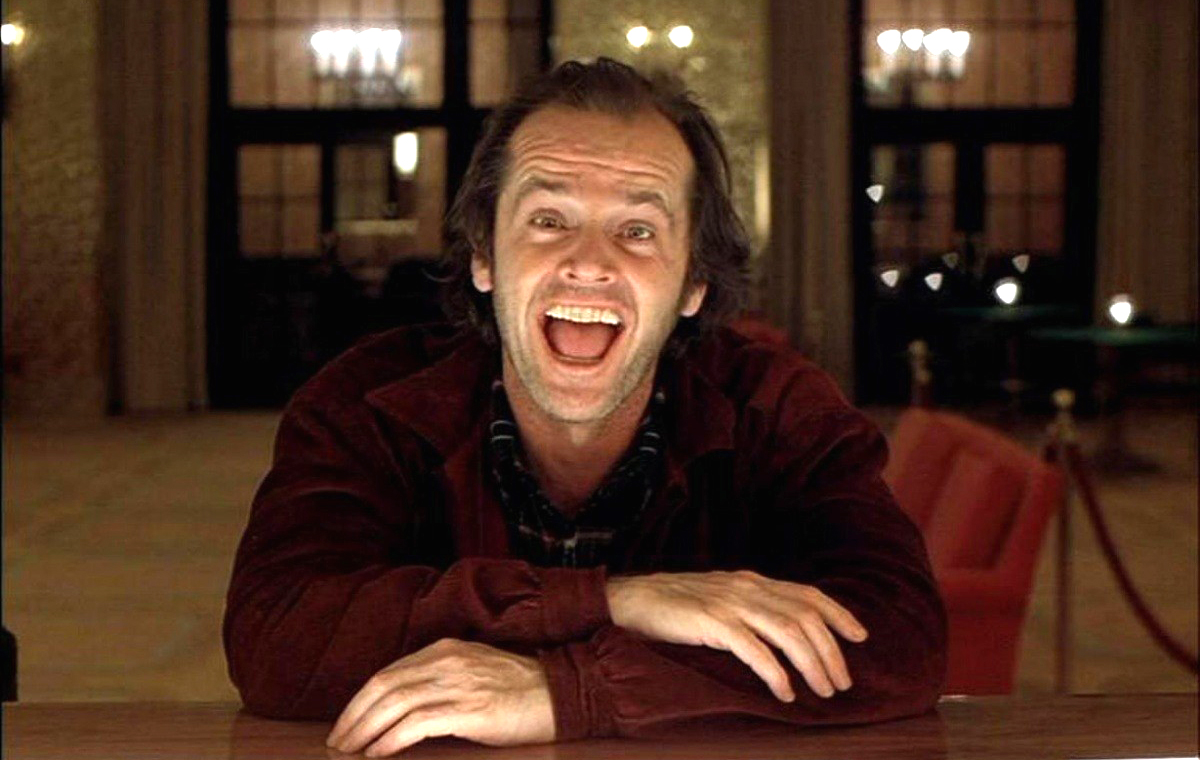The Book
Stephen King’s 1977 bestselling novel is a spin on the traditional haunted house story. When King and his wife, Tabitha, paid a late-season visit to The Stanley Hotel in Colorado, they found themselves the only guests in residence as the staff packed everything up for the winter. King was spooked by the silent, empty corridors, and, after a nightmare featuring his son running screaming through the hotel, came up with the bones of his book.
The Shining tells of supernatural forces putting pressure on an already fractured family. Jack Torrance takes the winter caretaking gig at The Overlook hotel knowing full well that he and his wife and child will be completely isolated up there once the snows come. Jack is a dry drunk, still struggling with alcoholic behaviors even though he’s not had an actual drink in months. He’s also suffering from writer’s block, and welcomes the idea of being able to work without distraction. His wife, Wendy, is struggling to keep their marriage alive and protect their psychically sensitive five year old son, Danny. Her choices are bleak: go along with Jack’s self-imposed exile from the world, or return to the mother she fears and hates.
The novel explores how The Overlook houses an evil, intelligent entity intent on killing – and therefore keeping – Danny under its roof and claiming his ‘shining’ power for itself. Before he leaves to spend the winter in Florida, Dick Halloran, the cook, identifies Danny as a fellow ‘shiner’. He warns the little boy that the hotel might have a few surprises in store, but reassures him that they lack the power to do physical harm:
“…it seems that all the bad things that ever happened here, there’s little pieces of those things still layin’ around like fingernail clippins or the boogers that somebody nasty just wiped under a chair. I don’t know why it should just be here, there’s bad goings-on in just about every hotel in the world, I guess, and I’ve worked in a lot of them and had no trouble. Only here… So, if you should see something, in a hallway or a room or outside by those hedges… just look the other way and when you look back, it’ll be gone.”
Looking the other way works for Danny and Wendy, but Jack is seduced by the ghosts, who play on his misery and rage, turning him into a physical tool for the destruction they can’t wreak themselves and sending him mad in the process. The Shining is primarily a ghost story, set in a haunted house, but it’s also a study of insanity under pressure.
The Movie
Stanley Kubrick’s take on The Shining is substantially different to the book. Rather than being about a family, it’s about a location. The Overlook, as imagined by Kubrick, is a series of nightmare-inducing spaces that simultaneously cause claustrophobia and agoraphobia. Kubrick eschews the supernatural explanation that the hotel is an evil entity which manifests via a spectral corpse in the bathtub or topiary creatures that come to life. Instead he suggests it’s an extreme case of sick building syndrome: something rotten in the architecture and the carpet designs burrows into Jack’s brain and sends him over the edge. Kubrick intimates this “something rotten” is the fault of those who built a hotel on a once-sacred Native American site.
Aesthetic
The Shining looks like no other horror movie, thanks to Kubrick’s 360° vision, which resulted in an arduous and protracted production process. Kubrick and his production designer, Roy Walker, created the then-largest ever set at Elstree Studios, and spent over a year shooting on it. The Overlook was created as an amalgam of many different hotels – the red men’s room where Jack talks to Grady was inspired by the Arizona Biltmore.
The Colorado Lounge was designed after the Ahwanee Hotel in the Yosemite Valley. In order to give The Overlook a specific identity, Kubrick used Native American designs in the carpets and stained glass windows. There are hints that the hotel is built over an ancient burial ground, and that this might be the source of the malevolent energy that pervades its walls.
Kubrick was one of the earliest directors to use the Steadicam, to great (and, for its time, unique) effect in the shots where the camera floats down corridors behind Danny’s tricycle. The Steadicam also enabled Kubrick to shoot scenes on sets with four walls, which helps add to the sensation that the hotel is perpetually closing in on the characters.
A notorious perfectionist, Kubrick spent months getting the look that he wanted, and often did upwards of 30 takes of each shot. He was very hard on the actors in the process, exhausting them with long days and constant script changes. Shelley Duvall became physically ill from stress.
Kubrick’s vision bears only a basic resemblance to its source material. The most haunting images of the film are not in the book: Danny’s tricycle, blood pouring from the elevator,the twins, the maze, the piles of manuscript pages filled with “All work and no play makes Jack a dull boy” typed over and over again and the final shot of a young, healthy Jack at a Fourth of July party at The Overlook in 1921. The movie met a mixed critical reception upon release (probably because it defies every genre convention there is), but has since been re-evaluated as a masterpiece, and often appears on lists of top all-time horror movies.
The Shining – or at least the complicated intentions behind it – is also the subject of a 2012 documentary, Room 237, which delves into the conspiracy theories surrounding it.
